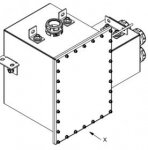Karthik_venna
Member
Hello All,
I have read a lot of discussions regarding eddy currents and hysteresis heating when the conductors are entering into an enclosure made of ferrous elements like steel.
however my question is what would be the effect when a two parallel conductors of same phase entering separately in to a steel enclosure. For eg: In the below drawing, imagine Conductor 1 (Phase A) & conductor 2 (Also Phase A) are entering but with out a narrow slot cut between the entries. The entering cable glands are fixed with plastic lock nuts.
My question is Should I be worried of any induced heating issues. I do not think so as the both conductors belong to the same phase. Kindly correct me if i am wrong

Best regards
Karthik
I have read a lot of discussions regarding eddy currents and hysteresis heating when the conductors are entering into an enclosure made of ferrous elements like steel.
however my question is what would be the effect when a two parallel conductors of same phase entering separately in to a steel enclosure. For eg: In the below drawing, imagine Conductor 1 (Phase A) & conductor 2 (Also Phase A) are entering but with out a narrow slot cut between the entries. The entering cable glands are fixed with plastic lock nuts.
My question is Should I be worried of any induced heating issues. I do not think so as the both conductors belong to the same phase. Kindly correct me if i am wrong
Best regards
Karthik


